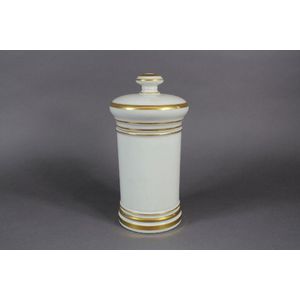Georgian Sterling Silver Pepper Pot, London 1808
Georgian sterling silver pepper or pounce pot, with tapering body marked 1808, London, approx 9 cm high & 54g
You must be a subscriber, and be logged in to view price and dealer details.
Subscribe Now to view actual auction price for this item
When you subscribe, you have the option of setting the currency in which to display prices to $Au, $US, $NZ or Stg.
This item has been sold, and the description, image and price are for reference purposes only.
- Sterling Silver - Sterling silver is a mixture of 92.5% pure silver and 7.5% of another metal, usually copper. Fine silver is 99.9% pure silver, and is relatively soft and the addition of the very small amount of copper gives the metal enough strength and hardness to be worked into jewellery, decorative and household objects.
- Pounce - Pounce is a finely ground powder made from a mixture of salt, sand, talc, pumice and soapstone. It was used in the era before the invention of blotting paper and was sprinkled over wet ink to speed up the drying process. It was commonly stored in a pounce pot, a container similar to a salt shaker, but with a concave top to allow the unused pounce to be returned to the container. The containers were made wood, silver or ceramic, and were sometimes a component of an inkstand.
- Georgian - As an English stylistic period, Georgian is usually taken to cover the period from George I (1714) to the Regency of Prince George (1811-20), although the period from 1800 to 1830 is sometimes designated as the Regency period. During the Georgian period the great English cabinetmakers and designers such as Chippendale, Hepplewhite, Adam Sheraton etc., were all active.
Therefore there isn't a single 'Georgian style' as such and to say something is 'Georgian', usually means it was made between 1714 and 1830. This assumes we discount George V and George VI, both being from the 20th century.
The styles popular at the time of each reign were:
George I (1714-1727) saw out the last years of the Baroque period.
George II (1727-1760) reigned during the Rococo period.
George III (1760-1820) saw the last gasp of the Rococo, all of the early Neo-Classic 'Adam style' and most of the later neo-Classic 'Regency style'.
George IV (Prince Regent 1820-1830)encompassed the last of the 'Regency' style.
William IV's reign (1830-1837) was something of a no man's land (stylistically) and he wasn't a 'George' anyway. He covered the last glimmerings of 'Regency' and the start of the 'Victorian' style.
This item has been included into following indexes:
Visually similar items

Antique porcelain chemist bottle with gilt highlights, 26 cm high
Sold by
in
for
You can display prices in $Au, $US, $NZ or Stg.

Chinese bone snuff bottle. Erotic scene decoration. Height 7 cm
Sold by
in
for
You can display prices in $Au, $US, $NZ or Stg.

Four various glass decanters, to include hobnail, gilt highlight etc and shaft and globe (4)
Sold by
in
for
You can display prices in $Au, $US, $NZ or Stg.

Lalique perfume bottle, 19 cm high
Sold by
in
for
You can display prices in $Au, $US, $NZ or Stg.
